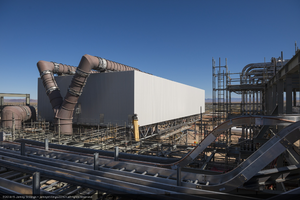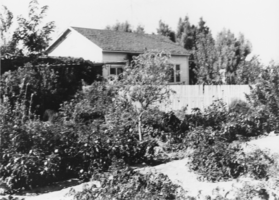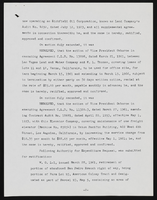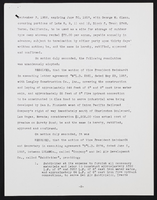Search the Special Collections and Archives Portal
Search Results

The air cooled condenser at Crescent Dunes Solar, near Tonopah, Nevada: digital photograph
Date
Archival Collection
Description
Photographer's assigned keywords: "110 megawatts; CSP; Concentrated Solar Energy; Concentrated Solar Power; Crescent Dunes; NV; Nevada; Solar Reserve; SolarReserve; Tonopah; concentrated solar thermal; green energy; ground-based photo; molten salt; on-site; renewable energy; storage; tower."
Image

House and garden belonging to Gordon and Billie Bettles: photographic print
Date
Archival Collection
Description
From the Nye County, Nevada Photograph Collection (PH-00221) -- Series I. Amargosa Valley, Nevada -- Subseries I.A. Fishel Family (T&T Ranch). The house was occupied by Betty-Jo Boyde and her husband in 1990, was moved to the site by the Bettles from Death Valley Junction, California. The site was bare land when the Bettles moved onto it. As this picture testifies, Billie Bettle's reputation as a skilled gardener is fully justified.
Image
Linda Hartley oral history interview
Identifier
Abstract
Oral history interview with Linda Hartley conducted by Pauline Marchese on March 10, 1978 for the Ralph Roske Oral History Project on Early Las Vegas. During the interview, the two discuss Hartley’s personal history, such as schools that she had attended and her recollection of local recreational activities. The two go on to talk about changes in crime, the environment, and briefly discuss a variety of issues at the time, including: segregated schools, prostitution, and effects of the Nevada Test Site.
Archival Collection
Roosevelt Toston oral history interview
Identifier
Abstract
Oral history interview with Roosevelt Toston conducted by Claytee D. White on July 11, 2006 for the Boyer Early Las Vegas Oral History Project. Toston discusses moving to Las Vegas, Nevada in the 1950s and his various careers at the Test Site, Bell Telephone of Nevada, as a television anchorman and cameraman, and the Convention and Visitors Authority to bring conventions to Las Vegas. He also talks about ways African American entrepreneurs might get involved in the convention business.
Archival Collection
Hoover Dam, 1930-1965
Level of Description
Scope and Contents
Materials contain photographs of the Hoover Dam and surrounding areas from 1930 to 1965. The Hoover Dam, also known as the Boulder Dam, was constructed on the Colorado River in Black Canyon near Las Vegas, Nevada from 1931 to 1936 during the Great Depression. The dam impounds Lake Mead, the country's largest reservoir, and it provides hydroelectric power to Nevada, Arizona, and California.
Materials also include photographs of the Pueblo Grande de Nevada archaeological sites, also known as the "Lost City," which were partially covered by the waters of Lake Mead. The area originally belonged to Puebloan peoples. Additionally, the materials contain photographs of the town of St. Thomas, which was also submerged beneath Lake Mead.
Archival Collection
Collection Name: Elbert Edwards Photograph Collection
Box/Folder: N/A
Archival Component

Kids Voting 2000 Project report
Date
Archival Collection
Description
From the Alpha Kappa Alpha Sorority, Incorporated, Theta Theta Omega Chapter Records (MS-01014) -- Chapter records file.
Text




